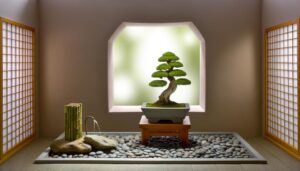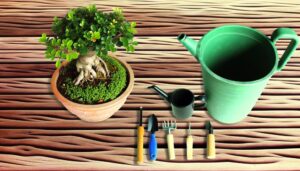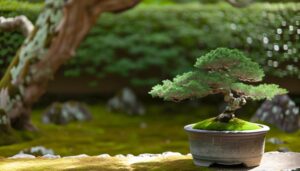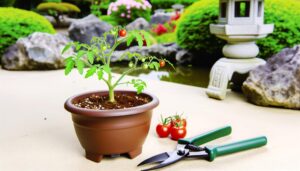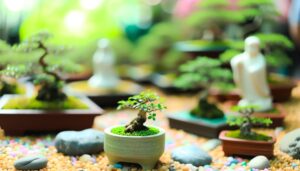10 Different Kinds of Bonsai Plants to Grow at Home
Bonsai plants comprise a variety of species, each with unique attributes. Juniper Bonsai, from genus Juniperus, thrives in diverse climates and features needle-like leaves.
Maple Bonsai (Acer genus) is known for its vibrant, seasonal foliage and elegant branching. Ficus Bonsai, including Ficus retusa, offers resilience and indoor adaptability.
Pine Bonsai, such as Japanese Black Pine, requires well-draining soil and full sun. Azalea Bonsai showcase vibrant blossoms and complex branching.
Bougainvillea Bonsai needs full sunlight and meticulous pruning. Jade Bonsai thrives with precise watering and indirect sunlight.
Cherry Blossom Bonsai demands consistent moisture and sunlight. Exploring further reveals more about these intricate plants.
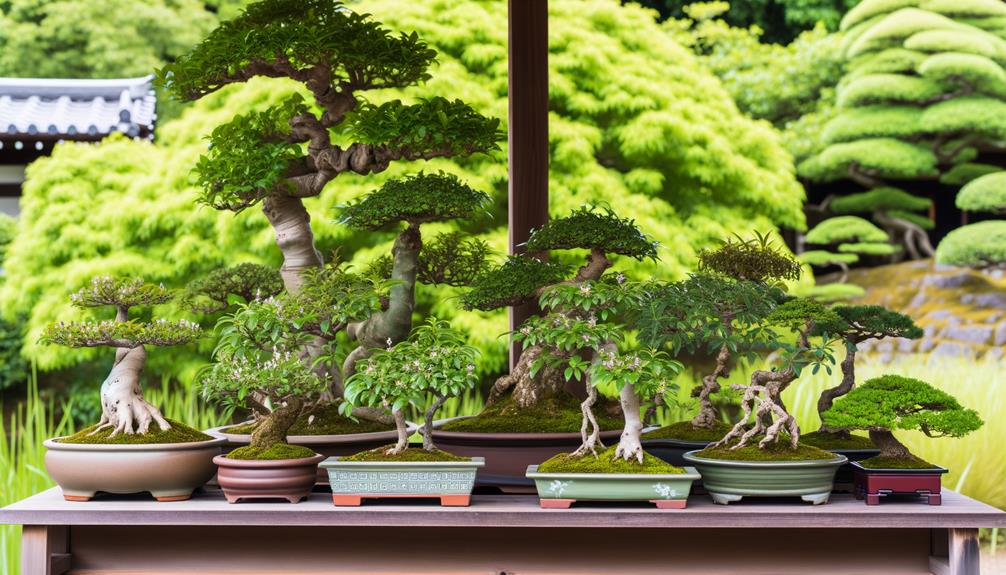
Key Takeaways
- Juniper Bonsai thrives in diverse climates and features needle-like or scale-like leaves.
- Maple Bonsai is known for its vibrant seasonal foliage and elegant branching structure.
- Ficus Bonsai, including Ficus retusa, is resilient and adaptable for indoor cultivation.
- Pine Bonsai, such as Japanese Black Pine, requires well-draining soil and full sunlight.
- Azalea Bonsai is famous for its vibrant blossoms and requires well-drained, acidic soil.
Juniper Bonsai
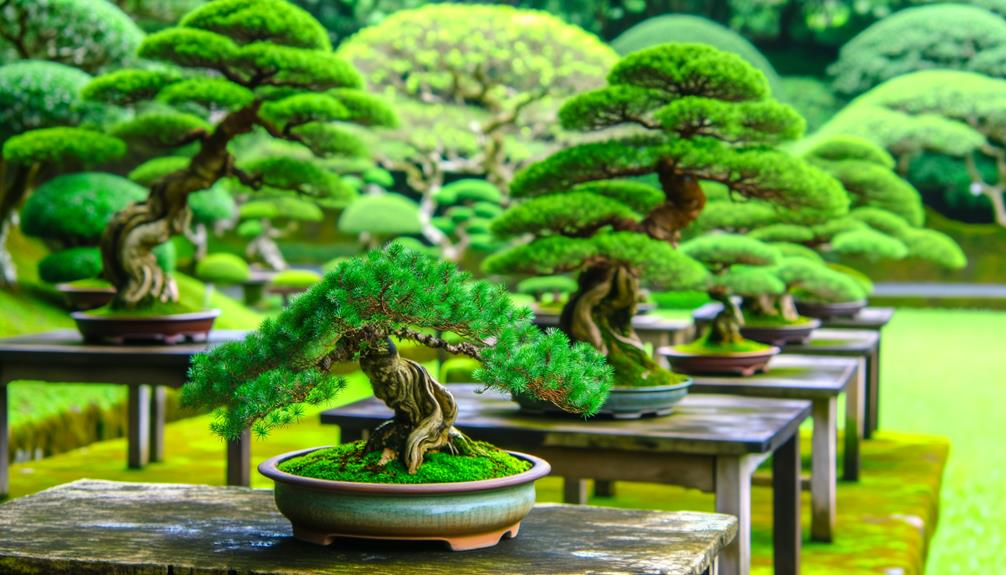
Juniper Bonsai, belonging to the genus Juniperus, are highly cherished in the bonsai community for their hardy nature and versatile adaptability to various bonsai styles. This genus encompasses a wide array of species, including Juniperus chinensis and Juniperus procumbens, each presenting unique foliage textures and growth habits.
Known for their resilience, Junipers thrive in diverse climatic conditions, making them ideal for both indoor and outdoor cultivation. Their needle-like or scale-like leaves and rugged bark contribute to their aesthetic appeal. Advanced techniques such as jin and shari are often employed to enhance the dramatic, aged appearance of Juniper Bonsai.
Proper care involves precise watering, well-draining soil, and regular pruning to maintain their miniature stature and intricate form.
Maple Bonsai
While Juniper Bonsai are celebrated for their rugged resilience, Maple Bonsai, particularly from the genus Acer, captivate enthusiasts with their vibrant, seasonal foliage and elegant branching structure. These deciduous trees are prized for their intricate leaf patterns, which evolve through a spectrum of colors throughout the year.
Key characteristics of Maple Bonsai include:
- Leaf Morphology: Exhibiting a variety of forms from deeply lobed to palmate structures.
- Seasonal Coloration: Leaves shift from verdant greens in spring and summer to fiery reds, oranges, and yellows in autumn.
- Branch Architecture: Naturally elegant, with a propensity for graceful, spreading branches.
- Growth Rate: Moderate growth rate, allowing for precise shaping and maintenance.
Maple Bonsai necessitate meticulous care, emphasizing correct watering, pruning, and seasonal protection.
Ficus Bonsai
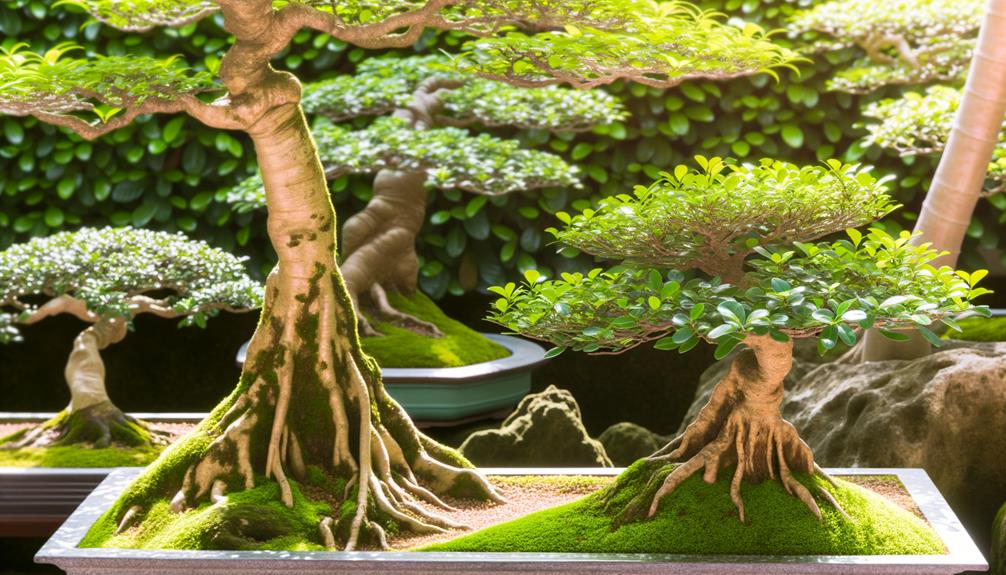
Ficus Bonsai, encompassing popular varieties such as Ficus retusa and Ficus benjamina, are renowned for their resilience and adaptability, making them perfect for indoor cultivation.
The care and maintenance of Ficus Bonsai involve precise watering schedules, excellent light conditions, and careful pruning to encourage aerial root development and maintain structural integrity.
Understanding the specific requirements of each Ficus species is crucial to fostering a thriving bonsai specimen.
Popular Ficus Varieties
Renowned for their resilience and adaptability, popular Ficus varieties in bonsai cultivation include the Ficus retusa, Ficus benjamina, and Ficus microcarpa, each distinguished by unique characteristics and growth habits.
The Ficus retusa, known for its robust trunk and aerial roots, exhibits a dense foliage structure ideal for intricate styling.
Ficus benjamina, with its delicate, glossy leaves and graceful arching branches, appeals to enthusiasts for its aesthetic elegance.
The Ficus microcarpa, notable for its compact size and smooth, light-grey bark, is often chosen for its ease of shaping and maintenance.
- Ficus retusa: Robust trunk, aerial roots, dense foliage.
- Ficus benjamina: Glossy leaves, arching branches.
- Ficus microcarpa: Compact size, smooth bark.
- Ficus religiosa: Heart-shaped leaves, prominent venation.
Care and Maintenance
Proper care and maintenance of Ficus bonsai require an understanding of their specific watering needs, ideal lighting conditions, and pruning techniques to guarantee healthy growth and aesthetic appeal. Regular watering is essential; the soil should remain slightly damp but not waterlogged. Adequate lighting, preferably indirect sunlight, supports their photosynthetic requirements. Pruning is necessary to maintain their miniature size and shape, focusing on shape refinement and branch structure.
| Aspect | Details |
|---|---|
| Watering | Damp, well-draining soil |
| Lighting | Indirect, bright light |
| Pruning | Regular, to maintain shape and health |
| Humidity | High humidity, mist foliage occasionally |
| Soil | Loamy, enriched with organic matter |
Incorporating these techniques guarantees the Ficus bonsai remains vibrant and robust.
Pine Bonsai
Pine Bonsai, known for their resilience and aesthetic appeal, require specific growth and care practices such as strategic pruning and consistent watering schedules to thrive.
Notable varieties, including Japanese Black Pine (Pinus thunbergii) and Scots Pine (Pinus sylvestris), each have unique characteristics suited for bonsai cultivation.
Best environmental conditions, particularly well-draining soil and full sun exposure, are essential for maintaining the health and vigor of Pine Bonsai.
Growth and Care Tips
Achieving optimal growth and maintaining the health of a pine bonsai necessitates a thorough understanding of its specific watering requirements, soil composition, and pruning techniques. Pine bonsai thrive when provided with meticulous care:
- Watering: Secure consistent moisture without waterlogging; allow the soil's surface to dry slightly between waterings.
- Soil Composition: Utilize a well-draining, slightly acidic soil mix, integrating components like akadama, pumice, and lava rock.
- Pruning: Conduct regular structural pruning to maintain form and perform needle plucking to balance energy distribution.
- Fertilizing: Apply balanced fertilizer during the growing season, tapering off in late summer to prepare for dormancy.
Careful attention to these elements secures robust growth and longevity, fostering an aesthetically pleasing and healthy pine bonsai.
Popular Pine Varieties
Among the myriad of pine species suitable for bonsai cultivation, a few standout varieties are particularly revered for their aesthetic appeal and adaptability to miniature form.
The Japanese Black Pine (Pinus thunbergii) is celebrated for its rugged bark and dark green needles, providing a striking contrast in any bonsai collection.
The Japanese White Pine (Pinus parviflora) is known for its soft, bluish needles and elegant, twisted branches that enhance its visual complexity.
Scots Pine (Pinus sylvestris) offers a robust growth habit and distinctive orange-red bark.
Importantly, the Mugo Pine (Pinus mugo) is valued for its compact needle clusters and resilience.
Each of these varieties embodies unique characteristics, making them quintessential choices for bonsai enthusiasts seeking refinement and diversity.
Ideal Environmental Conditions
Cultivating pine bonsai requires meticulous attention to specific environmental conditions, ensuring ideal growth and longevity. Pine bonsai thrive in well-ventilated areas with abundant sunlight, as these conditions mimic their natural habitats. Proper humidity levels and temperature control are critical for maintaining the tree's health and vigor.
Sunlight Exposure: Pine bonsai necessitate at least six hours of direct sunlight daily to sustain photosynthesis and robust growth.
Temperature Range: Excellent growth occurs within a temperature range of 60-75°F (15-24°C), although they can tolerate brief periods of frost.
Humidity Levels: Maintaining moderate humidity around 50-70% helps prevent needle desiccation and supports overall health.
Soil Composition: A well-draining soil mix, rich in organic matter, is essential to prevent root rot and facilitate nutrient uptake.
Azalea Bonsai
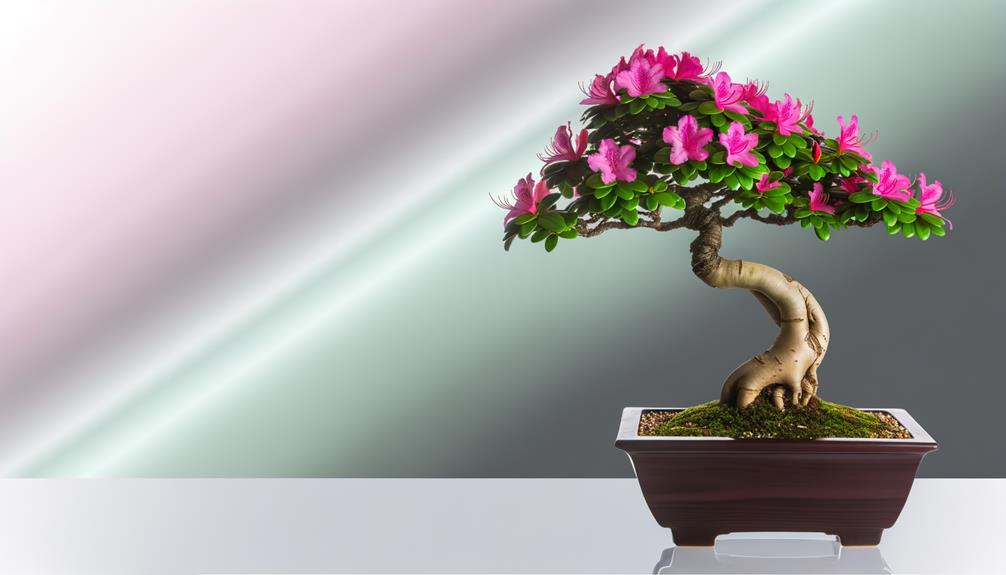
Renowned for their vibrant, long-lasting blossoms and intricate branching patterns, Azalea Bonsai are a popular choice among bonsai enthusiasts for their aesthetic appeal and horticultural challenge. Native to Asia, Azaleas (Rhododendron spp.) require meticulous care, thriving in well-drained, acidic soil and benefiting from partial sunlight. Their pruning demands precision to maintain structural integrity and promote prolific flowering. Fertilization during the growing season, combined with proper watering practices, ensures prime health and vitality.
| Aspect | Description |
|---|---|
| Soil Requirements | Well-drained, acidic soil |
| Light Preferences | Partial sunlight |
| Pruning Techniques | Precise pruning to maintain structure and blooms |
Azalea Bonsai often exhibit a captivating range of colors, from deep reds to vibrant pinks, making them a visually striking addition to any bonsai collection.
Chinese Elm Bonsai
Shifting focus from the vibrant Azalea Bonsai, the Chinese Elm Bonsai (Ulmus parvifolia) stands out with its resilient nature and finely-textured foliage, making it a favorite among bonsai practitioners for its adaptability and aesthetic versatility. This deciduous species is renowned for its ability to thrive both indoors and outdoors, offering a visually appealing canopy of small, serrated leaves. Cultivators appreciate its robust growth and capacity for detailed wiring.
Key characteristics include:
- Resilient growth: Tolerant of various lighting conditions and temperatures.
- Fine-textured foliage: Small, serrated leaves that maintain year-round visual appeal.
- Adaptable root system: Easily pruned to fit various pot sizes.
- Distinctive bark: Smooth, mottled bark that exfoliates to reveal shades of gray and orange.
The Chinese Elm Bonsai's versatility and dynamic appearance make it indispensable in bonsai artistry.
Bougainvillea Bonsai
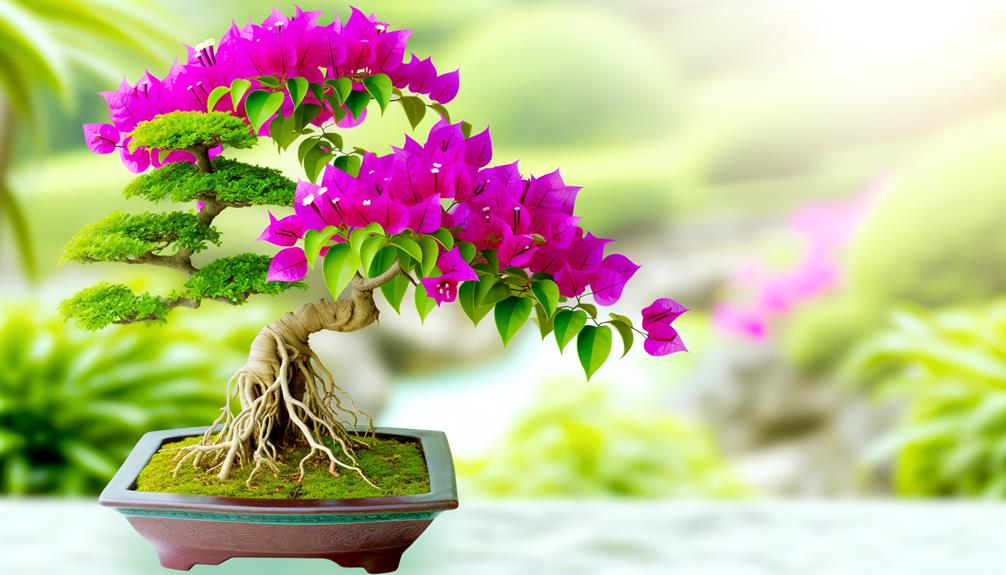
Among the diverse species suitable for bonsai cultivation, the Bougainvillea Bonsai stands out due to its vibrant bracts and woody vines, presenting a unique set of challenges and rewards for experienced growers.
Characterized by its vigorous growth and thorny stems, Bougainvillea requires meticulous pruning to maintain its miniature form. Best growth is achieved under full sunlight, with well-draining soil to prevent root rot. Regular fertilization, focusing on phosphorus, enhances bract coloration. Wiring must be done cautiously to avoid damaging the brittle branches.
Dormancy periods necessitate reduced watering, while ensuring humidity levels prevent dehydration. Pests such as aphids and spider mites are common, necessitating vigilant monitoring and prompt intervention to preserve the plant's health and aesthetics.
Jade Bonsai
Jade Bonsai, known for its succulent leaves and robust trunk, requires specific care and maintenance to thrive, including precise watering schedules and specialized soil mixtures to prevent root rot.
Effective pruning techniques are essential to maintain its compact form, involving strategic cuts to encourage back-budding and branch ramification.
Best growing conditions necessitate bright, indirect sunlight and temperature regulation to prevent stress-induced leaf drop.
Care and Maintenance Tips
Proper care and maintenance of a Jade Bonsai (Crassula ovata) involve meticulous attention to factors such as watering frequency, lighting conditions, soil composition, and pruning techniques to guarantee growth and health. Maintaining ideal conditions requires adherence to specific guidelines:
- Watering Frequency: Allow the soil to dry out between waterings to prevent root rot, as Jade Bonsai are drought-tolerant.
- Lighting Conditions: Provide indirect sunlight for at least 4-6 hours daily to promote robust foliage.
- Soil Composition: Utilize well-draining soil, ideally a succulent or cactus mix, to ensure sufficient aeration and moisture control.
- Fertilization: Apply a balanced, water-soluble fertilizer monthly during the growing season to provide essential nutrients.
These practices promote a thriving and aesthetically pleasing Jade Bonsai.
Pruning Techniques
Pruning techniques for Jade Bonsai, including strategic branch trimming and foliage reduction, are essential for maintaining the plant's shape, encouraging dense growth, and ensuring best sunlight penetration.
Begin by identifying and removing any leggy, elongated branches to promote a compact structure. Utilize sharp, sterilized shears to make clean cuts just above a leaf node or branch junction to prevent dieback.
Periodic pinching of new growth tips can stimulate lateral branching, thereby enhancing the tree's fullness. Additionally, judicious thinning of overcrowded foliage clusters will improve air circulation and light distribution within the canopy.
Be vigilant about removing any crossing or inward-growing branches, as these can hinder the plant's aesthetic and structural balance. Regular, meticulous pruning fosters a robust and visually appealing Jade Bonsai.
Ideal Growing Conditions
Optimal growing conditions for a Jade Bonsai necessitate a balance of bright, indirect sunlight, well-draining soil, and controlled watering to prevent root rot and promote healthy growth. Guaranteeing these parameters will facilitate peak photosynthesis and nutrient absorption, crucial for robust development.
Sunlight:
Position in an area receiving 3-5 hours of indirect sunlight daily to avoid leaf burn yet maintain vigor.
Soil:
Utilize a substrate with high permeability, comprising components like perlite and coarse sand to ensure ample aeration.
Watering:
Implement a strict watering schedule—water sparingly, allowing the soil to dry out completely between sessions to avert root rot.
Humidity:
Maintain moderate humidity levels; excessive moisture can lead to fungal issues, while insufficient moisture can cause desiccation.
These elements collectively foster a thriving Jade Bonsai.
Cherry Blossom Bonsai
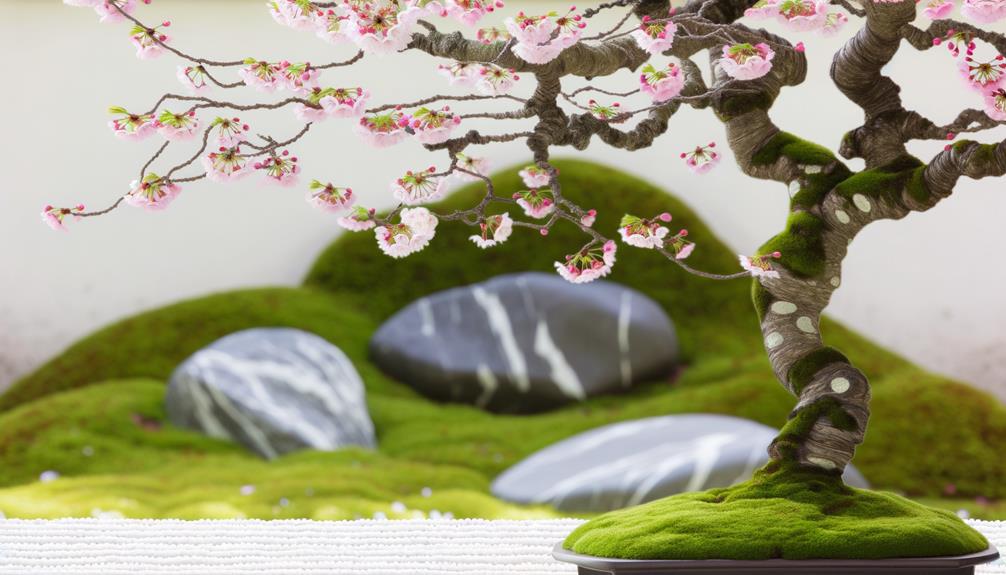
The Cherry Blossom Bonsai, known for its exquisite pink and white blossoms, requires meticulous care and precise environmental conditions to flourish successfully. Optimal growth necessitates a well-draining, slightly acidic soil mix, often incorporating akadama, pumice, and lava rock.
Consistent moisture levels must be maintained, avoiding both waterlogging and drought. Adequate sunlight, approximately six hours daily, is crucial, yet protection from harsh midday rays is essential. Pruning should be carried out post-flowering to promote vigorous growth and balanced structure.
Additionally, proper fertilization using a balanced, slow-release formula during the growing season enhances foliar and floral development. Vigilant monitoring for pests, such as aphids and spider mites, secures the plant's health and longevity, making it a rewarding yet challenging species.
Ginkgo Bonsai
Renowned for its distinctively fan-shaped leaves and striking yellow autumn foliage, the Ginkgo Bonsai presents a captivating blend of historical significance and horticultural elegance. This ancient species, often referred to as a 'living fossil,' demands meticulous attention and precision in bonsai form. The Ginkgo biloba's resilience and unique morphology make it a prized specimen among bonsai enthusiasts.
Key considerations for cultivating Ginkgo Bonsai include:
- Soil Composition: Utilize well-draining soil to prevent root rot.
- Watering Regimen: Maintain consistent moisture, avoiding waterlogged conditions.
- Pruning Techniques: Employ careful trimming to enhance structure and leaf reduction.
- Seasonal Care: Provide protection from extreme cold, especially in juvenile stages.
Following these practices guarantees the Ginkgo Bonsai thrives, displaying its aesthetic and historical beauty.
Conclusion
To sum up, the diverse array of bonsai plants, ranging from the resilient Juniper to the delicate Cherry Blossom, encapsulates a botanical tapestry as rich and varied as nature itself.
Each species, whether it be the robust Pine or the elegant Azalea, offers unique characteristics and cultivation requirements.
This intricate world of bonsai demands precise techniques and profound understanding to achieve the desired aesthetic.
Truly, the art of bonsai is a meticulous dance between horticultural science and artistic expression.

